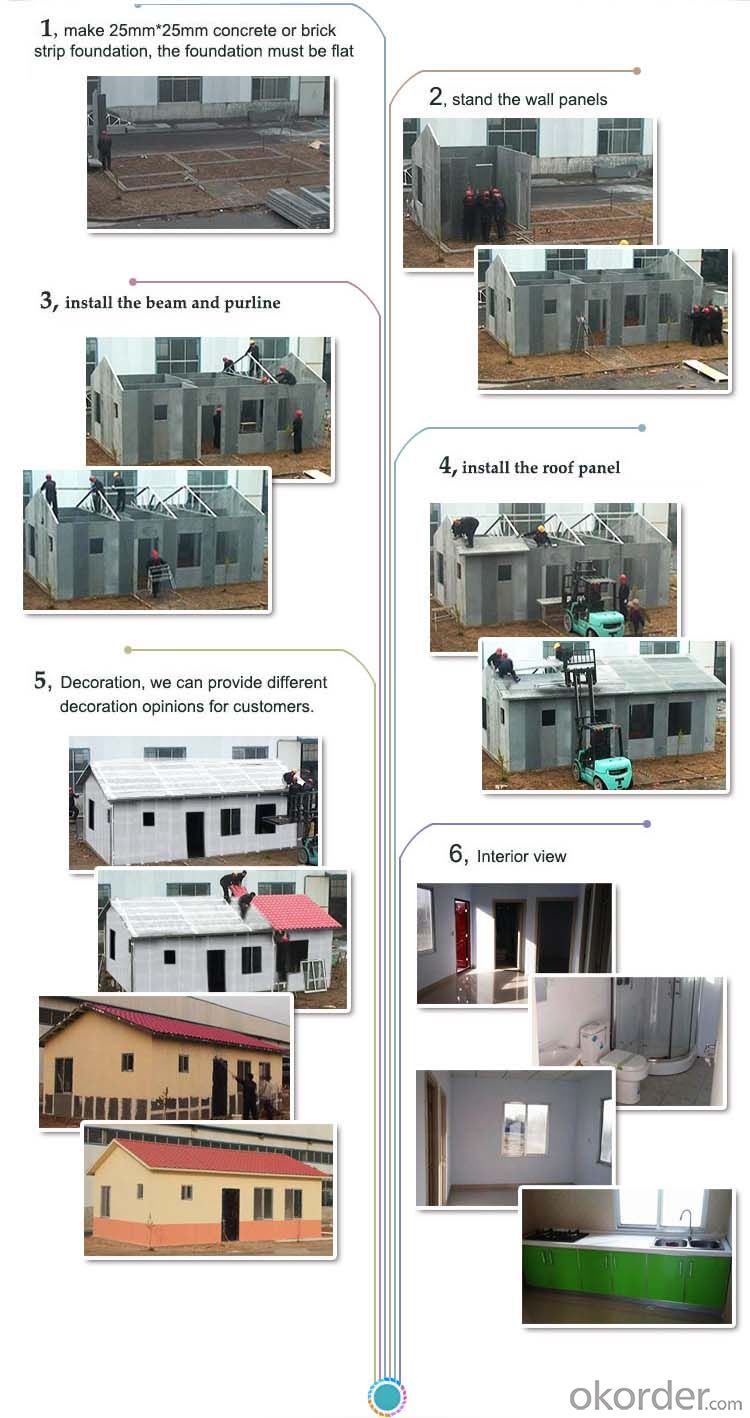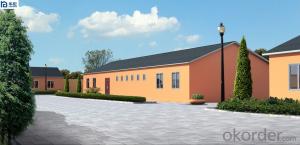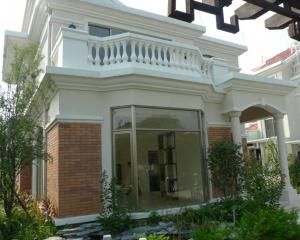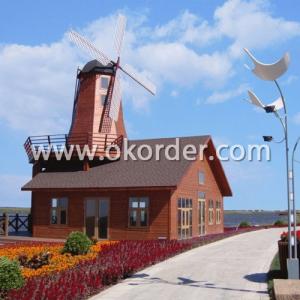New cement house
- Loading Port:
- China Main Port
- Payment Terms:
- TT OR LC
- Min Order Qty:
- -
- Supply Capability:
- -
OKorder Service Pledge
OKorder Financial Service
You Might Also Like
More questions:
1, What's your Payment term:
30% deposit by TT, 70% balance before loading container by TT; 100% LC at sight(total payment over 100,000USD);
2, How about Shipping:
We use 20 feet container and 40HQ container to ship the goods; Usually one 20 feet container can load about 50-60 square meters' house, 40HQ container can load about 120-140 square meters's house.
3, How to become your agent in our country:
First, you can make a report about your market, include the the rules and laws of prefab house, popular house models, target price, and potential sales quantity.
Second, you must place a trial order to act as the display.
Third, after finishing the sample house and getting the local people's feedback, we will give you the agent right in one area with limited time.
Fourth, Please note that we already have agent in Mumbai City India; Marshall Islands, Trinidad and Tobago.
4, Can you help me to purchase other things like furniture or appliance:
Because the customs law, our company can only export prefab house, so we just can purchase very little matched kitchen and bathroom facilities for you in consideration of customs clearance.
5, Can you send workers to help me build house.
Considering the labor cost, safety and visa issues, we suggest to send one or two engineers to guide and train your staffs. You must provide air tickets, hotel, and meal, and 100USD per day for engineer salary.

- Q:Can container houses be built with a sustainable cooling system?
- Certainly, sustainable cooling systems can indeed be implemented in container houses. There exist multiple options that can guarantee a sustainable and energy-efficient cooling system in these structures. One possible approach is to integrate passive cooling techniques. This entails designing the container house with features that make the most of natural airflow and shading to decrease the necessity for mechanical cooling. Strategies like appropriate insulation, reflective roofing, and ventilation can aid in maintaining a cool interior without heavily relying on energy-consuming cooling systems. Another alternative is to utilize renewable energy sources to power the cooling system. By installing solar panels on the container house's roof, electricity can be generated and subsequently used to operate energy-efficient air conditioning units or fans. This method reduces the dependence on fossil fuels and minimizes the environmental impact. Additionally, the incorporation of green technologies, such as geothermal cooling or the use of thermally efficient materials, can further enhance the sustainability of the cooling system. Geothermal cooling capitalizes on the constant temperature of the ground to cool the air, reducing energy consumption. Utilizing thermally efficient materials, such as insulation produced from recycled or sustainable materials, can help maintain a comfortable interior temperature while diminishing the need for excessive cooling. In summary, container houses can be designed and constructed with diverse sustainable cooling systems that curtail energy usage, mitigate environmental harm, and provide a comfortable living environment.
- Q:How to design villa lightning protection system?
- pay attention to the need for hot galvanized products; × 4mm hot dip galvanized flat iron
- Q:What is the cost of container renovation housing?
- the price will be very low, our unit built the container office is Looking for Shanghai Yiqiang Industrial Container Company built, the price is very low
- Q:Are container houses suitable for areas with high winds?
- Areas with high winds can be suitable for container houses, given proper design and construction to withstand these conditions. The modifications made to the original container and the foundation it rests upon greatly influence the structural integrity of the house. To enhance wind resistance, one can reinforce the structure by adding braces or welding extra steel beams to the container walls or roof. Additionally, securing the container to its foundation with hurricane straps or anchor bolts can prevent it from being lifted or blown away during strong winds. Considering the location and orientation of the container house is essential. Placing it in a wind-protected area, such as behind natural windbreaks like hills or trees, can mitigate the impact of high winds. Properly positioning the entrance and windows can also reduce the risk of wind damage. The choice of materials for insulation and cladding is another factor influencing wind resistance. Opting for resilient materials like reinforced concrete panels or fiber cement siding can provide an extra layer of protection against high winds. Ultimately, container houses can be suitable for high-wind areas, but it is vital to collaborate with experienced professionals who understand the unique challenges posed by the local climate. By carefully considering design, construction, and location factors, container houses can offer a secure and comfortable living space even in regions prone to strong winds.
- Q:Can container houses withstand natural disasters?
- Yes, container houses have proven to be able to withstand natural disasters to some extent. The strong and durable nature of the shipping containers used to build these houses makes them inherently resistant to certain natural disasters such as earthquakes and strong winds. The structural integrity of the containers allows them to withstand the forces exerted during these events. Additionally, container houses can also provide a safe and secure shelter during hurricanes and tornadoes. However, it is important to note that the level of resilience may vary depending on the design, construction, and location of the container house. Proper reinforcement and engineering techniques can further enhance their ability to withstand natural disasters.
- Q:What are the advantages of living in a container house?
- There are several advantages of living in a container house that make it an appealing option for many individuals. Firstly, container houses are incredibly cost-effective. Buying a shipping container and converting it into a livable space is significantly cheaper than purchasing or building a traditional house. This affordability allows individuals to save money or allocate their funds to other important aspects of their lives. Secondly, container houses are highly versatile and can be customized to suit individual needs and preferences. With some creativity and design expertise, containers can be transformed into comfortable and stylish living spaces. They can be customized to include various amenities such as windows, doors, insulation, electricity, plumbing, and even multiple stories. The ability to customize container houses provides individuals with the opportunity to create a unique and personalized living environment. Another advantage of container houses is their portability. Shipping containers are designed to be transported easily, making it possible to relocate your home if needed. This mobility is particularly beneficial for individuals who value flexibility and enjoy changing their living environment, such as frequent travelers or those who move frequently due to work or personal reasons. Furthermore, container houses are environmentally-friendly. By repurposing shipping containers, we reduce the demand for new construction materials, minimize waste, and contribute to sustainable living. Additionally, container homes can be designed to be energy-efficient, utilizing renewable energy sources and incorporating eco-friendly practices such as rainwater harvesting. Lastly, container houses are relatively quick to construct. Compared to traditional housing, which often takes several months or even years to build, container homes can be completed in a shorter period of time. The modular nature of containers allows for faster construction, reducing labor and material costs. In conclusion, living in a container house offers several advantages including affordability, customization, portability, sustainability, and faster construction. These benefits make container houses an attractive and viable housing option for those seeking a unique, cost-effective, and environmentally-conscious living experience.
- Q:Can container houses be built in a short amount of time?
- Yes, container houses can be built in a relatively short amount of time compared to traditional construction methods. Due to their pre-fabricated nature, container houses can be quickly assembled and modified to meet specific design requirements. This makes them a popular choice for those seeking a fast and efficient solution for housing needs.
- Q:Are container houses eligible for financing?
- Yes, container houses are eligible for financing. Just like traditional houses, container houses can be considered for financing through various methods. Some options include obtaining a mortgage loan from a bank or financial institution, applying for a personal loan, or exploring alternative financing options specifically tailored for container homes. However, it is important to note that eligibility may vary depending on the lender's criteria, the location of the container house, and other factors. It is advisable to research and consult with financial institutions or specialized lenders who have experience in financing container homes to determine the specific requirements and options available.
- Q:Are container houses prone to leaks or water damage?
- Container houses are generally not prone to leaks or water damage if they are properly designed and constructed. With proper insulation and sealing, container houses can effectively keep water out. However, it is important to note that like any other type of construction, the quality of materials and workmanship will play a significant role in preventing leaks and water damage. If the container is not properly sealed or if there are structural issues, such as rust or corrosion, it can lead to potential leaks or water infiltration. Regular maintenance and inspections are essential to ensure the integrity of the container house and prevent water-related issues. Additionally, proper drainage and landscaping around the house can help divert water away from the foundation, reducing the risk of water damage. Overall, with careful planning, appropriate construction techniques, and regular maintenance, container houses can be just as resistant to leaks and water damage as traditional houses.
- Q:Can container houses be built with a washer and dryer?
- Indeed, it is possible to construct container houses with a washer and dryer. Although the interior space of a container may be limited, there exist innovative approaches to integrating these appliances into the design. In the case of smaller container houses, one can install a washer-dryer combo, which is a combined unit that performs both washing and drying functions, thereby optimizing space. Furthermore, certain container house designs feature a distinct laundry area or a designated section specifically designed for a stackable washer and dryer arrangement. By meticulously planning and utilizing the available space, container houses can certainly accommodate a washer and dryer.
1. Manufacturer Overview |
|
|---|---|
| Location | |
| Year Established | |
| Annual Output Value | |
| Main Markets | |
| Company Certifications | |
2. Manufacturer Certificates |
|
|---|---|
| a) Certification Name | |
| Range | |
| Reference | |
| Validity Period | |
3. Manufacturer Capability |
|
|---|---|
| a)Trade Capacity | |
| Nearest Port | |
| Export Percentage | |
| No.of Employees in Trade Department | |
| Language Spoken: | |
| b)Factory Information | |
| Factory Size: | |
| No. of Production Lines | |
| Contract Manufacturing | |
| Product Price Range | |
Send your message to us
New cement house
- Loading Port:
- China Main Port
- Payment Terms:
- TT OR LC
- Min Order Qty:
- -
- Supply Capability:
- -
OKorder Service Pledge
OKorder Financial Service
Similar products
New products
Hot products
Related keywords





























